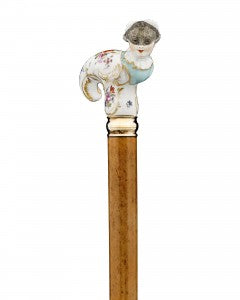Virtually since the dawning of history, walking sticks have been wielded for utilitarian purposes, and since the 17th century, they emerged as stylish fashion accessories in their own right. Yet, when one thinks of a walking stick, it is often the dapper gentleman that comes to mind, complete with tophat and tails. Yet, this timeless accessory offers a chic addition to the wardrobes of both men and women alike. For women in particular, the right walking stick can add charm and grace to both one’s ensemble and one’s stature.
In many ways, the walking stick is the ideal reflection of etiquette, elegance, and pure sophistication. Emerging as “the fashion” in the 17th century, canes became a part of a woman’s daily attire. In the elegant Victorian era, any poised and distinguished woman would not enter into the public arena without this stylish accessory. Consequently, the walking stick became a prevailing symbol of taste and class. The more feminine walking sticks were meticulously crafted and designed to reflect the female qualities of sophistication and delicacy.
As walking sticks became more fashionable and en vogue for women, designs became more and more elaborate. Scrambling to appeal to the stylish women, artisans crafted increasingly ornate and luxurious designs to adorn their walking sticks. Falling under the influence of new artistic trends and innovative styles, these canes featured extravagant designs from elaborate enameling to jewel-encrusted knobs by specialized jewelers and artisans.

Considered one of the greatest and transformative eras in history, the Baroque artistic movement embodied ideals of extravagant and curvilinear properties. This new style put on display extravagant ornamentation, influencing surrounding artisans to follow in its footsteps of movement and emotional exuberance. The KPM Berlin porcelain factory adhered to these new tendencies and produced feminine walking sticks topped with porcelain knobs of veiled maidens to match the elegance and delicacy that its female patrons exemplified.
Floral Canes…
The flamboyant, ornamental trends of the Rococo artistic movement inspired an entirely new era of women’s style in the fashion world. For any sophisticated lady’s wardrobe, new styles now featured striking patterns that exuded a sense of elegance and playfulness. One of the most powerful decorative elements at play were exaggerated floral designs and motifs that had never been seen before. For the most fashionable ladies, these foliate designs embellished all different pieces of their finery, including walking sticks.
The dawning of the 19th century meant important and transformative things for ladies’ accessories. Bold statement pieces dripping with large colored gemstones became a lady’s choice jewelry piece. Prominent designs firms, particularly Carl Fabergé, sought to match these new trends with accessories that imbued extravagance with strong feminine influences. Topping walking sticks with precious gemstones and exquisite regal details, such as guilloche enameling and gold, Fabergé was able to appeal to the female taste for finery.





